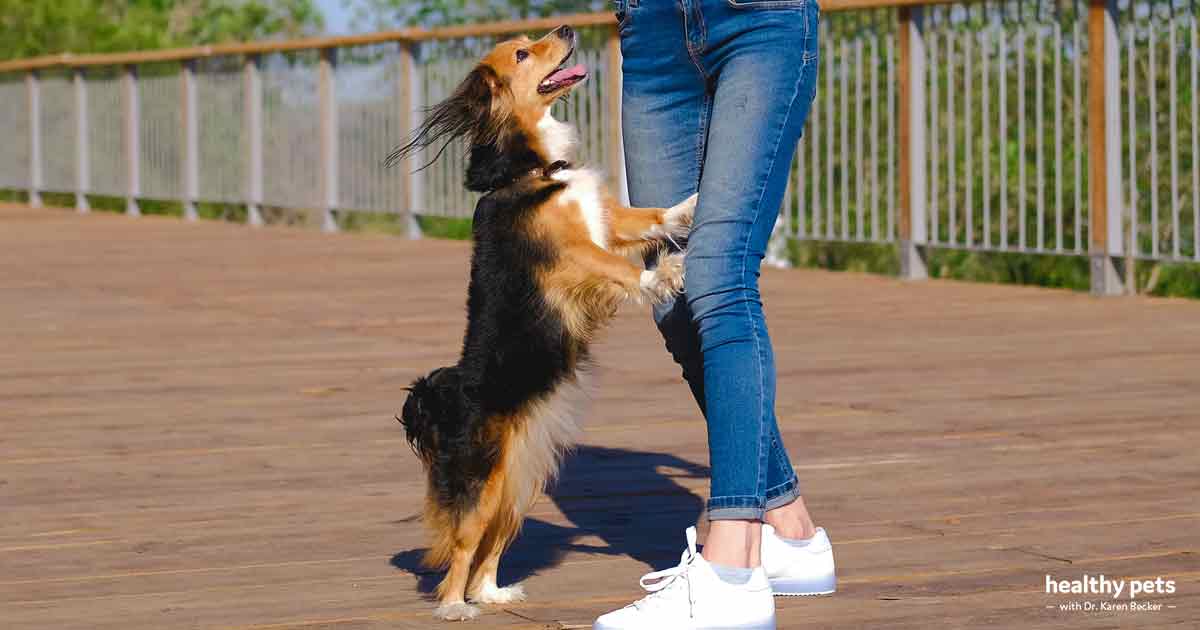A wrongdoing that is bothersome, possibly harmful, and likewise rather typical in canines is leaping up on individuals. It’s so typical, in truth, that it seems like a natural canine response to the enjoyment of welcoming a preferred human, or a minimum of a human who is understood to use deals with!
The individual being got on is frequently hesitant to fix the habits —– specifically if the pet dog is little —– because, well, it’s great to get such a happy, luxurious welcome! Stopping working to prevent leaping in your canine can have unanticipated effects that are challenging to anticipate as you look down at her pleased, fuzzy little face.
Experts normally concur that a pet dog’s habits is usually connected to something his caretaker, fitness instructor and/or owner did or didn’t do eventually in her life. There are 3 habits in specific that many pet moms and dads do not value however might be inadvertently strengthening: asking, leash pulling and yes, leaping.
These habits have actually been making pet moms and dads insane permanently, and they appear practically difficult to snuff out —– possibly since it’s in fact simpler to accidentally motivate them than to train canines not to perform them, and as soon as trained, it’s likewise simple to reverse your effort.
.Why Punishment Is Never the Right Approach.
I believe among the most tough principles for pet moms and dads to understand when it pertains to training their canine buddy is that penalty is usually inefficient, and it’s frequently detrimental. Simply put, you can make your pet dog’s habits even worse utilizing punitive techniques. As veterinary behaviorist Dr. Valarie Tynes discusses:
” When penalty is utilized improperly, it will appear complicated and unforeseeable, numerous animals end up being nervous or afraid around the owner that administers the penalty. [penalty is utilized in an effort to train an animal that is nervous or currently scared the] worry and stress and anxiety are most likely to intensify and might result in aggressiveness.” 1
According to Tynes, 3 crucial guidelines need to be fulfilled for penalty (correction) to be reliable:
.The penalty should happen each time the undesirable habits takes place The penalty needs to be administered within a 2nd or 2 of the unsuitable habits The penalty should be aversive sufficient to stop the pet from duplicating the undesirable habits in the future however not be so aversive regarding terrify the pet dog.
Unless your pet dog is physically connected to you (e.g., you have him on the leash and a leash is connected to you in some way), it will be incredibly hard to be on top of him when he misbehaves, and within a 2nd or more of his mischief.
In addition, in my experience it’s the unusual person who can provide “simply enough” penalty to train a pet dog not to duplicate the habits without frightening him, or on the other hand, without teaching him to just overlook spoken commands.
In other words, it’s simple to over-deliver or under-deliver penalty. It can result in both psychological and physical damage to your pet dog if you permit anger into the formula. The other side of the coin is penalty that’s non-committal and so wishy-washy the canine finds out to merely overlook you. As Tynes mentions:
” Meeting all 3 of these requirements can be tough. That’s why penalty frequently stops working to fix habits issues and must not be the very first training approach of option. Favorable support training, in which animals are rewarded for proper habits, is much safer and more efficient.”
I definitely concur with this, and can’t worry highly enough the significance of favorable support habits training , not just to assist your canine end up being a great canine resident, however likewise to safeguard and protect trust, and the close and valuable bond you show him.
.Penalty Can Backfire With a Jumping Dog.
Tynes offers the example of a pet dog who welcomes individuals by leaping up on them, and the owner’s action is to either knee the pet in the chest or kick her when she does it to them. As an outcome, the pet finds out to prevent the owner since the kicking has actually triggered her to be afraid. She continues to leap on everybody else.
” Many pets are extremely encouraged to welcome individuals by getting near to their faces,” Tynes describes. “In many cases, kneeing or kicking such a canine is less effective than the pet dog’s desire to welcome individuals by getting on them.”
I believe this is great info that can advance your understanding of your pet’s inspiration if he’s likewise a “dive greeter.” Simply as some individuals welcome everybody they consult with a huge hug and a kiss, it appears there are canines who are likewise influenced!
Since not everybody the leaping pet dog fulfills reacts to her habits with a kick or a knee (thank goodness), the penalty she gets is periodic, and for that reason inadequate. In addition, there are pet dogs who do not view being kneed as penalty, however rather support since they’re getting attention, albeit unfavorable attention.
Kneeing a leaping pet dog or even worse, kicking her as a kind of penalty (or just to keep her off you) does not teach her a more appropriate habits to change the inappropriate one. In addition, you can trigger injury to her and/or yourself utilizing your knee or foot versus her. Due to the fact that you’re paying attention to her when she leaps, and there’s likewise the concern of accidentally enhancing the bad habits.
.A Better Way to Manage Your Jumper.
Canine “dive greeters” require a replacement habits that is similarly encouraging. Tynes recommends mentor your pet to sit to welcome everybody. Sitting ends up being the alternative habits that gets rewarded with petting and/or a food reward.
While he’s being taught to sit to welcome individuals, it’s crucial to stop responding when he gets on you. Turn your back, stand directly, and neglect him. This is the reverse of what he desires (attention) and sends out the message that you do not invite his abundant leaping regimen.
The objective of favorable support habits training is to utilize extremely small-sized deals with (pea sized is excellent, and you can even utilize frozen peas if your pet appears to like them) and spoken appreciation and love to motivate wanted habits in your pet.
.Develop brief, ideally one-word commands for the habits you wish to teach your family pet. Examples are Come, Sit, Stay, Down, Heel, Off, and so on. Make certain all members of your household regularly utilize precisely the exact same command for each habits. As quickly as your pet carries out the preferred habits, benefit him instantly with a reward and spoken appreciation. Do this whenever he reacts properly to a command. You desire him to link the habits he carried out with the reward. This obviously implies you’ll require to have deals with on you whenever you provide your pet commands in the start. Keep training sessions brief and enjoyable. You desire your pet dog to associate advantages with following your commands. You likewise wish to utilize training time as a chance to deepen your bond with your family pet. When your pet has actually found out a brand-new habits, slowly back off the deals with and utilize them just periodically. Ultimately they’ll no longer be needed, however you need to constantly reward him with spoken appreciation whenever he complies with a command. Continue to utilize favorable support to keep the habits you prefer. Reward-based training assists develop a variety of preferable habits in your animal, which constructs shared sensations of trust and self-confidence.
No matter what you’re attempting to train your pet dog to do or not do, consistency is the essential to success. If your mind is frequently in other places throughout interactions with your canine, in an immediate you can start to unwind days, weeks or perhaps months of training.
If your pet is a jumper or has other unfavorable habits and you’re uncertain you can handle it by yourself, talk with a favorable pet fitness instructor or a veterinary behaviorist . You can likewise discover directory sites of credentialed pet specialists at the following websites:
Certification Council for Professional Dog Trainers (C.C.P.D.T.) International Association of Animal Behavior Consultants (I.A.A.B.C.) Karen Pryor Academy Academy for Dog Trainers Pet Professional Guild Sources: Bark December 2020 .
Read more: healthypets.mercola.com




Recent Comments